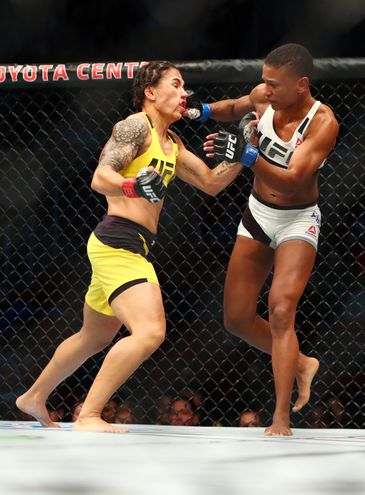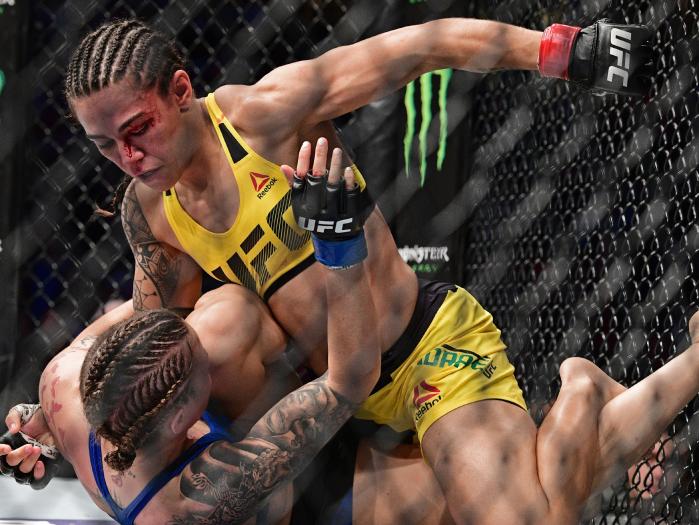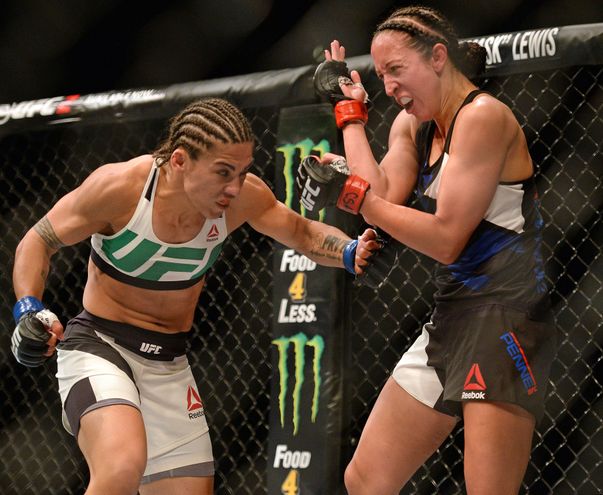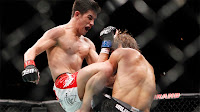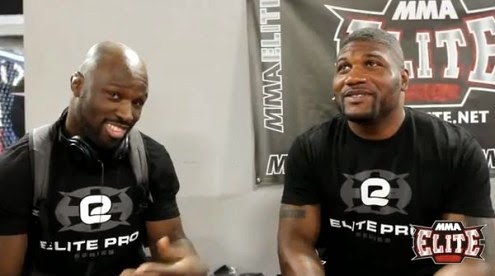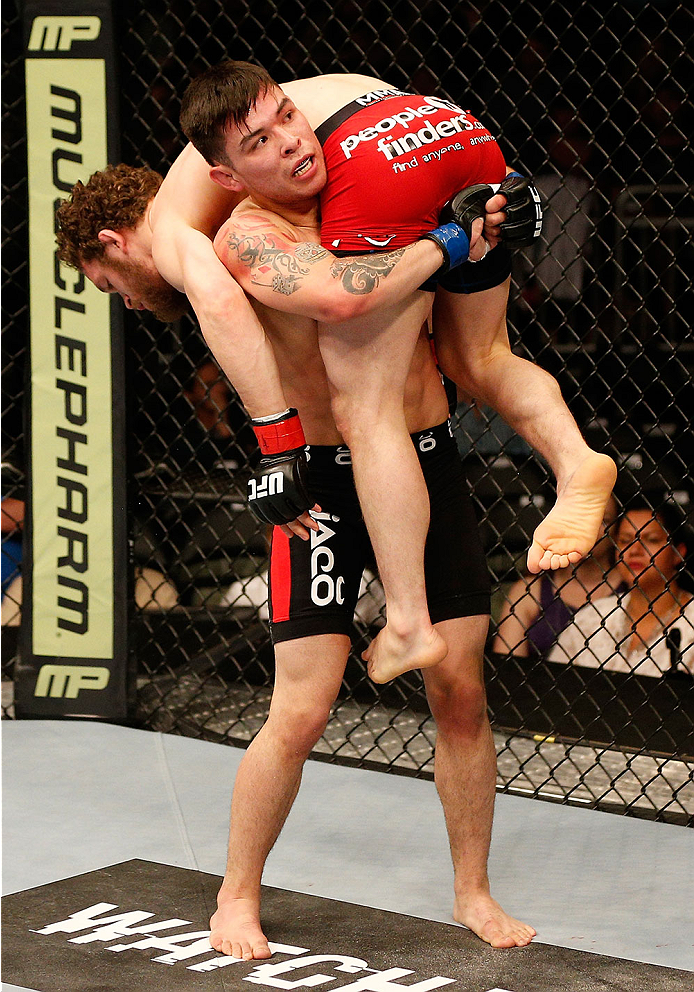Two weekends ago, a hype train rolled into UFC on FOX 23, when a fighter who had moved divisions and gone on an amazing win streak against increasingly difficult opposition stood on the precipice of a title shot if he could get past the last and most difficult obstacle. This past Saturday at UFC Fight Night 104 we had a similar situation. Another fighter had changed divisions and gone on a streak against increasingly difficult (albeit flawed) opposition. However, that’s where the similarities end. Unlike Donald Cerrone’s hype train, which came to a screeching halt, this past Saturday’s hype train picked up speed and barreled through the obstacle on the way to the final goal of a title shot. The hype train was that of Jessica “Basta Estaca” Andrade, the obstacle being one Angela “Overkill” Hill, and the final destination being champion Joanna Jedrzejczyk.
We still don’t know how good Jessica Andrade is as a fighter; her time at bantamweight revealed some very obvious flaws in regard to her overall skill set and cage IQ. And while she has improved her overall performance in fights and in their final results, we still see the same limited skills and dependency on the physical tools she has been blessed with. At bantamweight this lack of layers and nuance forced her to leave the division, as her skills were not up to par when faced with opponents she couldn’t physically dominate with strength, durability, physicality, and power.
In her first two fights in her new weight class, it seemed as though we had seen some real growth in her skills, as she was an offensive machine overwhelming Jessica Penne, and in her battle with Joanne Calderwood, we saw seemingly improved wrestling and submission grappling in a one-sided first-round submission win. These were the conclusions you could draw if you look at the fights platonically. But upon further inspection, you notice that neither opponent had the physical tools (either enough of them or the right combination) to expose the limitations or lack of subtlety in Andrade’s game. That is, until Saturday night, when Angela Hill had the durability, foot and hand speed, mobility, explosiveness, and power necessary to challenge Andrade’s physical skills. Hill possessed the technical skill set to test how dominant those physical skills were when Andrade had to consistently work to make them a factor.
There are a few ways to beat someone with Andrade’s particular style and physical abilities. The first would be to match her in physicality and strength, forcing her to exhaust herself fighting to impose her will and blunting her pressure enough that you could attack her technical shortcomings. The second way to beat her would be to generate enough power that you either dissuade her from being unrelenting in her pressure and volume, or stop her altogether. The final way is to have the technique and physical skills to move around, out-position her, and pick her apart with leads and counters, all the while showing the defensive awareness to limit her opportunities to attack and reduce the effectiveness of those attacks.
Penne is a light-hitting, physically weak, non-durable, and slow strawweight, high on experience, grappling and a limited (but solid) striking skill set; footwork, mobility, and defensive awareness and execution aren’t strengths of hers. Calderwood is big, strong, tough, durable, and hard-hitting, with efficient but not particularly nuanced or defensively responsible striking and grappling. This means both were incapable of executing any of the plans I listed. Neither had the physical tools that would allow them to put their technical skills in place. On the flip side, neither had the technical skills to make up for their physical shortcomings or manage the physical advantages Andrade possesses.
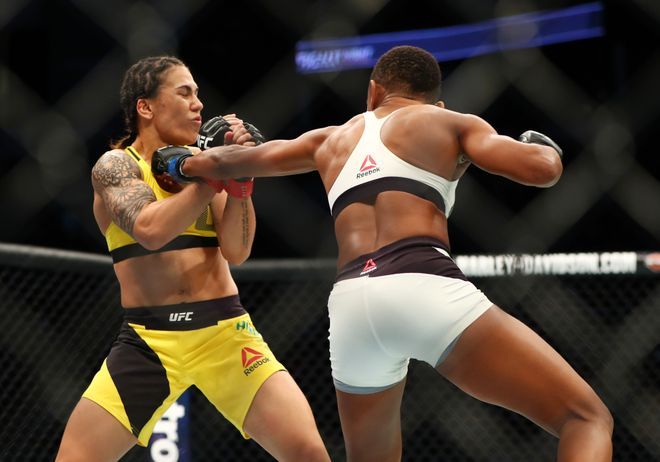 Until Hill came into the equation, there were a litany of questions regarding Andrade and her resurgence in this new division: What would happen if her opponent didn’t wilt under the pressure, if the opponent was able to make her work to get into and stay in the range she is most effective in, if her opponent beat her to the punch, exchanged with her, or was able to out-position her? These were things we didn’t know because no one had been able to create enough opportunities to force Andrade to answer, but Hill forced her to answer these questions. Hill showcased controlled aggression and defensive responsibility (especially under duress); she flashed head movement, pivots, and tie-ups in the clinch. Hill jabbed and threw kicks, lead knees, counter hooks, and extended flurries. On top of these technical responses to Andrade’s all-out physical assault, Hill showcased heart, grit, and athleticism, forcing Andrade to go harder and longer than she had in almost two years.
Until Hill came into the equation, there were a litany of questions regarding Andrade and her resurgence in this new division: What would happen if her opponent didn’t wilt under the pressure, if the opponent was able to make her work to get into and stay in the range she is most effective in, if her opponent beat her to the punch, exchanged with her, or was able to out-position her? These were things we didn’t know because no one had been able to create enough opportunities to force Andrade to answer, but Hill forced her to answer these questions. Hill showcased controlled aggression and defensive responsibility (especially under duress); she flashed head movement, pivots, and tie-ups in the clinch. Hill jabbed and threw kicks, lead knees, counter hooks, and extended flurries. On top of these technical responses to Andrade’s all-out physical assault, Hill showcased heart, grit, and athleticism, forcing Andrade to go harder and longer than she had in almost two years.
The questions were finally asked: What would happen to Jessica Andrade; what would change? The answer, not a damn thing. In the face of an opponent who would push back when pushed, get away from her offense, make her chase all over the ring and engage her in the clinch, Andrade kept on rolling, refusing to take a backward step; in fact, she increased her pressure and activity. She won the fight by showing that, not only was her brute strength and volume more than enough to beat the fringe contenders, but she had another gear to go to when facing the best opponent she has faced since dropping divisions. Andrade didn’t show new technical wrinkles or an ability to adjust; she did show that we haven’t seen the best she has to offer when it comes to how hard she can fight, how much she can take, and how hard she is willing to push to become a champion.
Andrade vs. Hill showed how much of a difference a change in divisions can make in the career of a fighter, as Jessica Andrade went from also-ran at bantamweight to the next challenger for the strawweight championship, and in the eyes of many, the stiffest test facing the champion since she became the face of the division. On top of establishing the newest and possibly biggest challenge for the champ, UFC Fight Night 104 reintroduced us to a renewed and rebuilt Angela Hill, who went from strawweight outcast to strawweight contender in the biggest spot, with the most attention, against the best opponent she had faced in her short career. Saturday night it got real — two fighters answered questions about their character, their class, and their place in the division moving forward.

UFC Fight Night 104: Bermudez vs. Korean Zombie took place February 4, 2017 at Toyota Center in Houston, Texas.
Click the stars to rate how good you think UFC Fight Night 104 was.
*********

